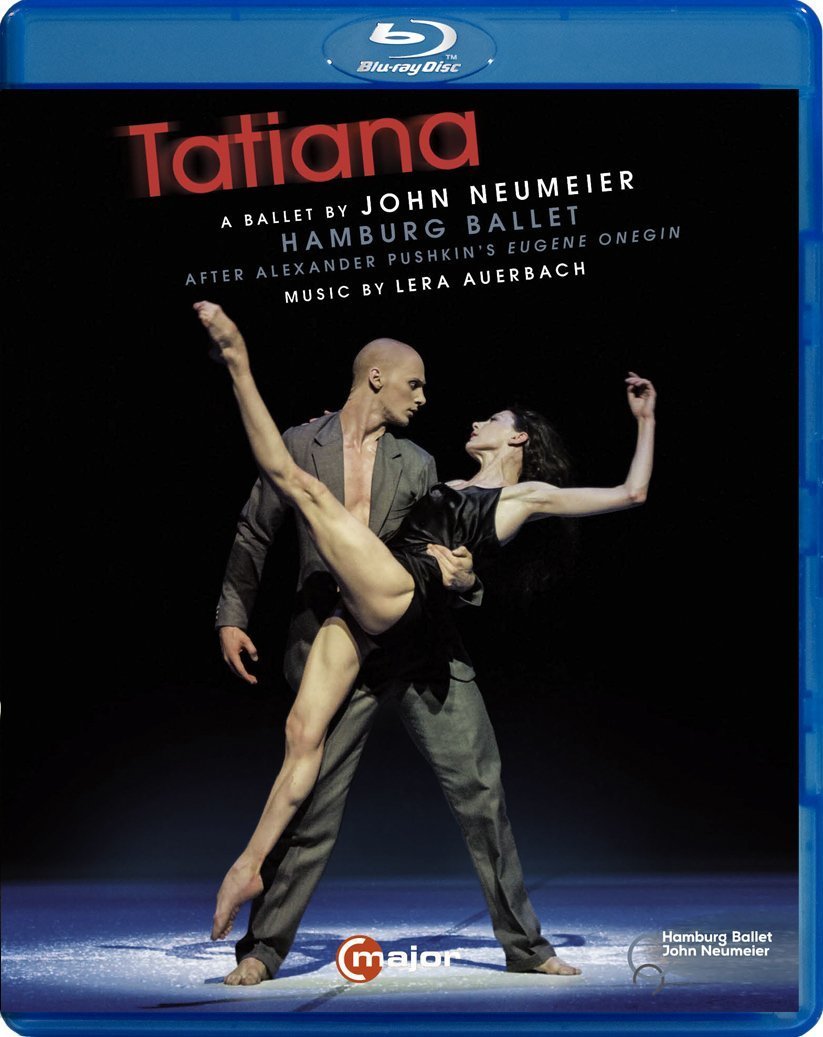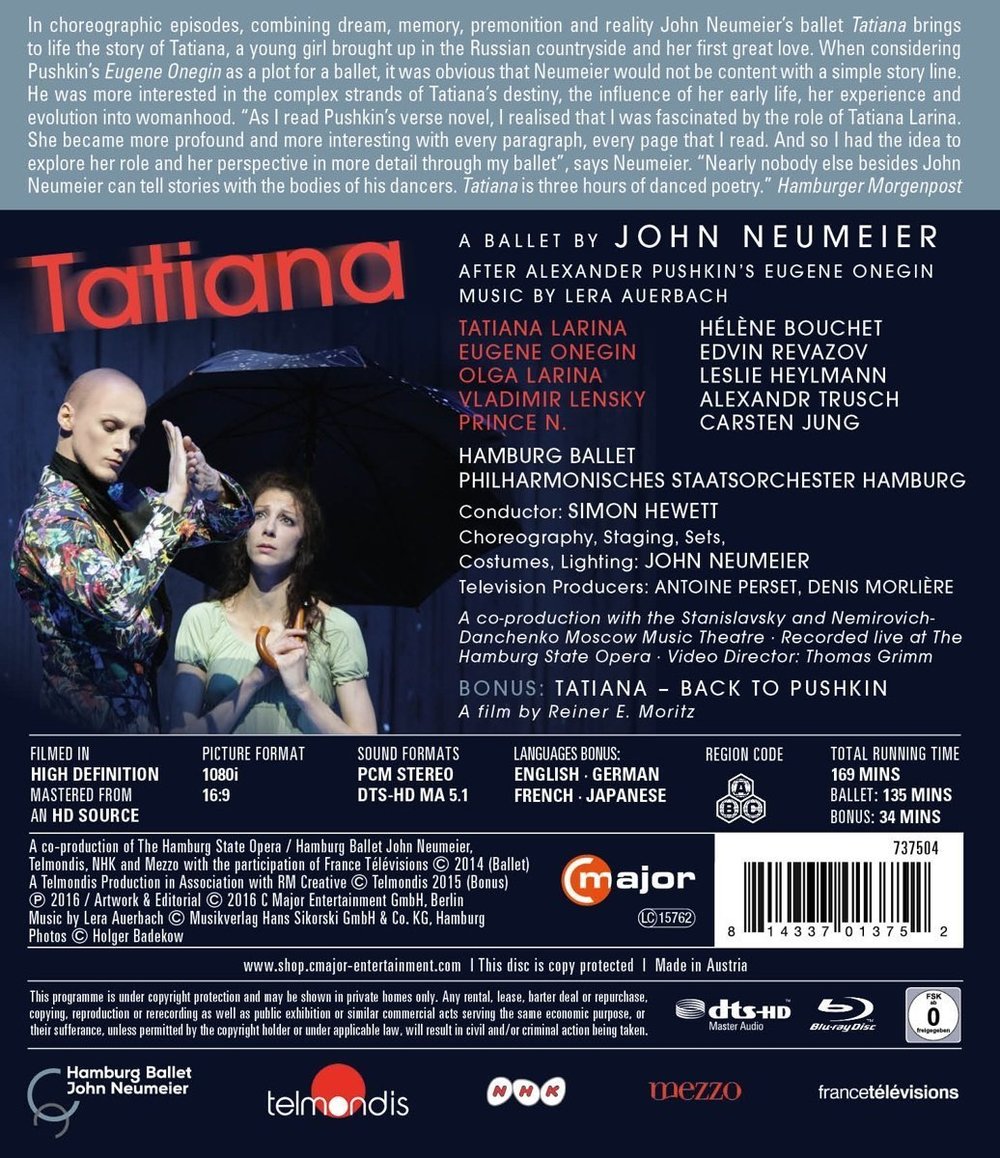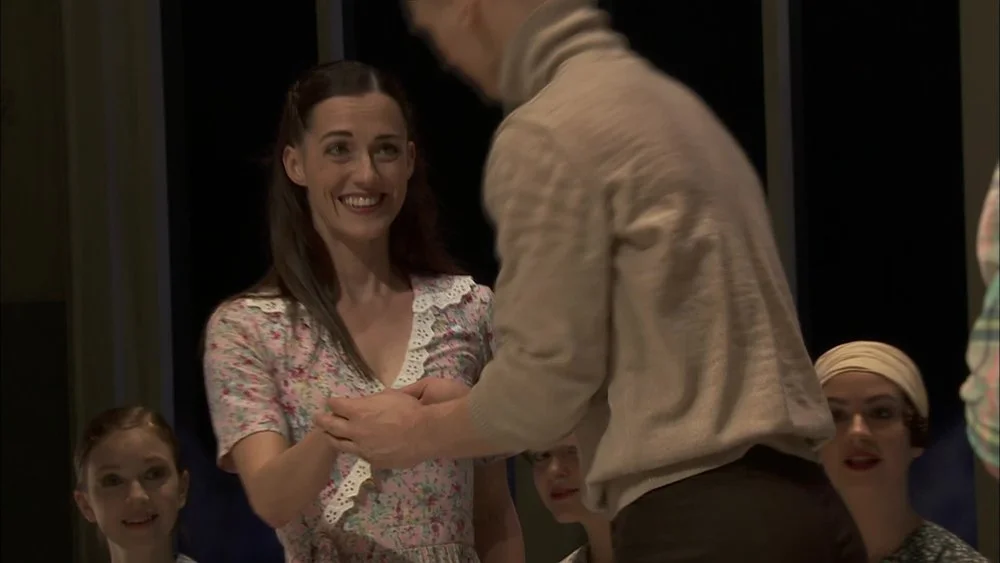

Tatiana ballet. Choreography by John Neumeier after Pushkin's Eugene Onegin. Music by Lera Auerbach. Performed 2014 by the Hamburg State Opera Ballet. Stars Hélène Bouchet (Tatiana Larina), Edvin Revazov (Eugene Onegin), Leslie Heylmann (Olga Larina), Alexandr Trusch (Vladimir Lensky), Carsten Jung (Prince N.), Niurka Moredo (Filipjevna, Tatiana's nurse), Sasha Riva and Marc Jubete (two males representing together Zaretsky, Lensky's second in the duel), Miljana Vračarić (Madame Larina), Xue Lin (The ballerina Istomina as Cleopatra), Silvano Ballone (Istomina's Partner as Marcus Antonius), Kiran West (Guillot), and Thomas Stuhrmann (An officer). Also features the following dancers as figures from Tatiana's novels: Hayley Page (Rousseu's Julie Wolmar), Florian Pohl (Saint Preux, Julie Wolmar's teacher), Braulio Álvarez (The "Sarazin" Malek Adhel, brother of the historical Saladin), Yaiza Coll (Matilda, Malek Adhel's lover and sister of Richard the Lionheart), Futaba Ishizaki (Harriet Byron), Jacopo Belussi (Grandison), and Edvin Revazov (Ruthven, the vampire). Simon Hewett conducts the Hamburg State Philharmonic Orchestra. Staging, sets, costumes, and lighting by John Neumeier. Directed for TV by Thomas Grimm; produced for TV by Antoine Perset and Denis Morlière. Bonus film by Reiner E. Moritz called Tatiana—Back to Pushkin. Released 2016, disc has 5.1 dts-HD Master Audio sound output. Grade: A-
Pushkin finished his long novel in verse, Eugene Onegin ("EO"), in 1830. It's considered the beginning and the apogee of Russian literature. At the heart of the poem is the tragic death of a poet (Lensky) in a duel. 7 years later Pushkin, a forward thinker, was slain himself in an unfair duel (perhaps really a kind of execution). The death of Pushkin in 1837 was one long lifetime away the Great Arrest in Russia in 1917. Pushkin has become a kind of mythic figure and symbol up to this very day of the failure of the liberal spirit to flourish in that nation.
Some 60% of EO deals with the sad love story of Eugene and Tatiana. 40% is about the future of Russia. Neumeier focuses, of course, on the love story. He takes the viewpoint of Tatiana, the character who emerges from the love story with the best future. In the first screenshot below we meet Tatiana (Hélène Bouchet) as a young girl, home-schooled in her mother's estate in the country far from Moscow. She is a shy dreamer immersed in romantic books and always close to her bear:
Next below we meet Olga (Leslie Heylmann), Titiana's younger sister, who is more practical and outgoing:
Olga has a boy friend, Lensky (Alexandr Trusch), seen next below. In the novel, Lensky is a budding poet (and thought by some to be the alter-ego of Pushkin). To make Lensky more vivid as expressed in dance, Neumeier turns him into a composer of music working at a piano and often dancing about with sheet music (sorry, no screenshot of this):
Pushkin includes in the EO novel a vast number of allusions to people and events in the artistic and political life of Russia in the early 19th century. Continuing in this vein, Neumeier includes 8 named characters from the novel who appear as "real people" in the ballet. In addition, Neumeier invents some 12 new characters (who are are referred to in some way by Pushkin in EO). Each of Neumeier's two Acts begins with an introductory medley scene in which many of these 20 characters appear, at random, in thoughts, dreams, memories, and premonitions. The invented characters can also appear at any time in the regular story scenes. For example, in the image below, we see Tatiana in the company of four ghostly figures from 19th-century romantic novels Tatiana is currently reading. If you worked hard enough, you could identify these 4 ghosts (I didn't try). Neumeier crams enough specific references to the novel into his ballet to satisfy the most passionate lover of literature and ballet trivia through many viewings of this production.
In addition, Chapter 5 of the poem describes a Tatiana nightmare! The stuffed bear becomes a real bear (Carsten Jung), who then sheds his coat (to keep the naked Tatiana warm), and emerges as her protector. Later the protector will be recognized as Prince N., Tatiana's future husband. If you are new to EO, all this will be quite a challenge. But don't let the many details keep you from enjoying the main story, which is easy enough to follow:
Now we meet Eugene, a jaded aristocrat with 4 women in his apartment. He has to get up early this morning as his servant brought him an important message:
His uncle has died, leaving Eugene a country estate far from Moscow in the vastness of Russian fields and forests:
While inspecting his new estate, Onegin befriends Lensky. With Lensky he visits the nearby Larina estate and meets the naive and innocent Tatiana:
Tatiana instantly falls in love. Following what she has learned from reading her novels, she writes a love letter to Onegin. The Letter bears the same place in Russian literature that the soliloquy "To be or not to be" has in English: everybody learns it in school. Neumeier's clever twist on The Letter has the ghosts writing it for Tatiana:
It's Tatiana's birthday (name day), and Onegin is invited to the party. Onegin wisely is wary. He decides to play the role of big brother to Tatiana rather than take advantage of her. His sanctimonious stuffiness makes his rejection even more crushing and humiliating to Tatiana than a treacherous seduction would have been. All this is acted out in an elaborate solo with many elements you will see again at the end of the story:
The rejection scene was stressful for Onegin also. He drinks a bit too much and starts to flirt with Olga to the dismay of Tatiana, Lensky, and Lady Larina (Miljana Vračarić), Tatiana and Olga's mother:
The flirting leads to a duel between two new friends. Lensky's Second at the duel is Zaretsky, a bumbler who partially gets the blame for the death of Lensky by failing (as required by dueling etiquette) to offer Onegin an easy way out. (Zaretsy should ask Onegin for a simple expression of regret). Neumeier elevates the role of Zaretsky by casting him as two dancers (Sasha Riva and Marc Jubete). They appear together many times in the ballet as a symbol of inevitable fate—a startling device I've never seen before:
Well, Tatiana has had the worst birthday party in all literature. Her beloved rejects her and later kills her sister's boyfriend. It was a bad day for Onegin as well, who immediately goes into self-imposed exile:
After the horrifying birthday party, Madame Larina goes to work finding husbands for both her daughters. Olga quickly marries a young army officer. Tatiana is shipped off to Moscow to be introduced by her aunts to society. There she becomes a great success and marries Prince N. (Carsten Jung). Next below we see Princess Tatiana with her husband attending a ball. The poem depicts Prince N. as an older and heavy man; Neumeier's Prince N. looks to me like a great catch for Tatiana:
Onegin has just returned from his wanderings and is also at the ball. He sees Princess Tatiana and realizes how beautiful she has become. He also finds himself suddenly in love with her. Prince N. notices nothing unusual:
Now it's Eugene's turn to write a love letter, but he can't find the right words:
Lensky finishes the letter for him:
The confounded couple meet one more time, and now Tatiana is offered a choice:
We already have 3 wonderful A+ story ballets from Neumeier in HDVD: (1) La Dame aux camélias, (2) the Bach Christmas Oratorio Ballet, and (3) The Little Mermaid. If you like these, you are going to like Tatiana also. All these works are well-known stories about women. Given familiar plots, Neumeier is able to add all manner of embellishment and clever angles that keep you alert and pleased. He does a great job of developing these works as theater as well as dance. This he accomplishes "in house" with a relatively small corps. Neumeier also has an uncanny ability to inspire amazing acting from his female leads, none of whom consider themselves to be actresses.
This time the astonishing performance is by Hélène Bouchet as Tatiana. You get the impression she could play Tatiana on stage or in a movie without dancing a step. All the other characters also can act. The Tatiana story has to have the duel. So it must be considered risky to update this story to modern times as Neumeier does here. Still, you get sucked into the story and you just don't care that nobody has fought a duel in well over the last 100 years.
In the past, I would have given this another A+ without much more thought. But I now have a couple of caveats. First, the Lera Auerbach original score is only adequate. Some critics harshly rejected her score as too abrasive. I listened to the score on pure audio setting, and I didn't make it all the way through. But then I couldn't think of any ballet score I've enjoyed audio only except for the famous Tchaikovsky works and maybe the Prokofiev Romeo and Juliet. As music to support the dancing, I find Auerbach serviceable.
I have a more serious reservation about video content. I ran the numbers on this ballet with a Wonk Worksheet. I was astonished to count 1,436 video clips! That yielded a video pace of 5.5 seconds per chip. If I had encountered this in a symphony video I probably would have diagnosed terminal DVDitis. The Hamburg stage is too big for Neumeier's small corps. The stage often looked underpopulated. That's probably why only 10% of the video clips show the whole stage. Also, my count shows hat only 52% of the video clips show the whole bodies of the dancers. In other words, there are too many no-feet shots, torso views, and close-ups. Thomas Grimm has shot all of Neumeier's Blu-ray videos, and this style of video is no accident.
I looked yet again at the Orpheus and Eurydike ballet from Pina Bausch shot by Vincent Bataillon at the Paris Opera Ballet. That's the video with an average clip of 77 seconds and 87% of its shots showing the whole bodies of dancers. Well, Tatiana has a more complicated plot than Orpheus and Eurydike, and the stage in Paris was smaller than the stage in Hamburg. But the big difference is clear. Bataillon used skillful, smooth panning to follow the action while maintaining a comfortable pace. In contrast, Neumeier and Grimm chop up their video in tiny pieces as they rapidly and sometimes violently jerk the attention of the viewer from place to place. Neumeier and Grimm probably think their approach makes their video more exciting. I think it tends to exhaust the viewer by demanding too much energy just trying to keep up with the camera.
I reduce the beginning grade of A+ for the weak score and video content to a B. But on account of the fine production and acting of the dancers, I bump the grade up to A-. I hope that Neumeier and Grimm will try to slow down the pace in their next project.
Here's a clip about Tatiana straight from the Hamburg Ballet:
OR






















